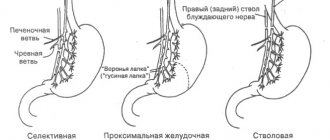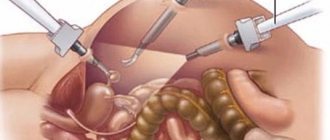Crohn's disease is a chronic disease that causes inflammation in the digestive tract. While medications are often effective in treating and preventing symptoms, some people may require surgery if standard treatment does not work. One type of surgery that a doctor may recommend for people with Crohn's disease is a bowel resection.
. This procedure involves removing part of the small intestine.
In this article, we will discuss what a bowel resection is and what to expect before, during, and after surgery. We will also look at the risks and complications, prospects, and other types of surgery for Crohn's disease.
What is a bowel resection?
Bowel resection is a surgical procedure that doctors use to treat some people with Crohn's disease. When inflammation affects the intestines, it can sometimes cause a stricture. Strictures are areas of the intestine that become narrowed due to significant inflammation and block the passage of digested food. Unresolved strictures can lead to severe abdominal pain and cramps. There may be healthy tissue on either side of the intestinal stricture. During a bowel resection, the surgeon removes only the damaged part of the intestine and then connects the two healthy ends.
Technique
Resection can be performed in different ways:
- Laparoscopic method. The operation is performed using special endoscopic video equipment. During the operation, only a few small incisions are made on the skin of the abdomen, which makes this method more gentle and avoids the appearance of large scars.
- Laparotomy method (open). It involves a wide dissection of the skin and underlying tissues, therefore it is more traumatic and unaesthetic, but there are pathologies when the surgeon needs to perform extensive intervention (most often oncology), and a minimally invasive operation will be ineffective.
There are several different ways to restore the passage of intestinal contents:
- Formation of intestinal anastomosis. The parts of the intestine that remain above and below the resected area are sutured.
- Formation of a colostomy. The afferent segment of the intestine is completely sutured and the afferent end of the intestine is removed to the anterior abdominal wall to form a colostomy (Hartmann operation). This can be either an intermediate or final stage of the operation.
The type, technique and extent of surgical intervention are determined by the attending physician, taking into account the type of pathology, its volume and the degree of intestinal damage. Also, the price for providing this service will depend on the method of operation.
Stages of surgery:
- Carrying out endotracheal anesthesia.
- Access to the sigmoid colon. The actions at this stage depend on the chosen method of operation (laparoscopic or laparotomy). For laparotomy access, an inferomedian incision is used.
- Revision of the abdominal cavity. In a minimally invasive operation, endoscopy is performed; in an open operation, a direct examination of the organ and adjacent tissues is performed.
- Mobilization of the section of intestine that will be removed. At this stage, the intestinal mesentery is dissected, as well as ligation, intersection of blood vessels and nerves.
- Resection of the affected area. The estimated volume of intervention is selected in the preoperative period, but the surgeon determines the final length of the area to be removed during the operation (during the revision). A section of intestine is removed along with the mesentery (in some cases, regional lymph nodes are additionally removed).
- Restoring the integrity of the intestinal tube. Depending on the indications, at this stage an anastomosis is created or a colostomy is placed on the anterior abdominal wall.
- At the final stage, drainage tubes are installed and the surgical wound is sutured.
If resection was performed for a malignant disease, then the operation is supplemented with chemotherapy and radiation treatments.
When is bowel resection necessary?
People with Crohn's disease usually require surgery, according to the National Institute of Diabetes and Digestive and Kidney Diseases. Research shows that about 60% of people have had surgery within 20 years of being diagnosed with Crohn's disease. A doctor may recommend surgery for people with strictures that don't respond to standard treatment. Bowel resection may be necessary when other types of surgery, such as strictureplasty, are ineffective or not an appropriate option. A stricture can slow down the absorption of food and cause several symptoms, including:
- bloating;
- abdominal pain and cramps;
- nausea and vomiting;
- constipation.
These symptoms can be very serious and can lead to potentially dangerous complications, such as a perforation forming in the intestinal wall. The doctor may also recommend bowel resection to form fistulas. A fistula is an artificial channel that forms between two different parts of the intestine or connects the intestine to another organ. Fistulas can occur after severe inflammation of the intestinal wall. During a bowel resection, the surgeon will focus on removing the fistula and the damaged tissue around it.
Cost of colectomy in Israel
The price of a colectomy in Israel depends on the type of surgery and technique (open, closed), the range is from $14,900 to $21,700. If you suffer from colon cancer and you would like to receive quality treatment abroad, find out the cost of cancer treatment abroad:
- Send a request using the contact form located on the website (pop-up window).
- Describe the problem to the medical specialist and send scanned copies of medical documents to the email address he/she will provide.
- Conduct a video consultation with an Israeli oncologist and answer the questions he asks.
After this, we will be able to draw up a treatment plan for you, indicating the cost of the necessary additional examination and treatment. This service is free.
How to prepare
Depending on the circumstances, the doctor may give certain recommendations to the person to prepare for surgery. These may include changes to the type or dosage of existing medications. Your doctor may also prescribe medications or antibiotics to prevent infection. A person may need to cleanse their intestinal tract the day before surgery. The doctor may advise the patient to use an enema, drink plenty of water, or drink a special solution that will help cleanse the intestines. Most surgeries require a person to fast from eating for a certain period before surgery. The doctor will tell the patient whether he needs to fast and for how long. Before fasting, it is best to eat healthy foods and avoid foods that can irritate your digestive tract.
Features of postoperative disorders depending on the site of resection
Depending on which part of the organ was removed, certain symptoms predominate.
In the small intestine, all types of nutritional compounds are digested, and the vast majority of hydrolyzed substances, vitamins, microelements and water are absorbed here. Resection of the small intestine leads to:
- deficiency of all types of nutrients in the body during their normal entry into the digestive tract;
- diarrhea due to a sharp decrease in water absorption.
Each part of the small intestine has its own job to do, so resection of different parts of the intestine results in different symptoms.
Water and nutrients are absorbed primarily in the upper intestine (jejunum). Secretions produced in the digestive tract, bile, and enzymes are absorbed mainly in the lower section (ileum), and part of the water is also absorbed here. That's why:
- Resection of the jejunum is not accompanied by diarrhea, since the remaining ileum takes over the absorption of fluid.
- Removal of the ileum causes severe diarrhea, since there is no place for the secretions produced in the previous parts of the tract to be absorbed, they liquefy the chyme, thereby causing watery, frequent stools. In addition, in the absence of the ileum, bile and fatty acids are not absorbed, which pass into the large intestine, where they attract water, aggravating diarrhea.
The ileocecal valve, which closes the passage between the small and large intestines, is of great importance in digestion. Removal of this valve during extensive resection of the small intestine:
- accelerates the passage of chyme, which leads to decreased absorption of electrolytes, nutrients and fluids;
- promotes the penetration of microflora from the large intestine into the small intestine, which leads to the appearance of excess bacterial growth.
In the large intestine, some of the water and electrolytes are absorbed, and feces are formed. The microflora of this part of the organ synthesizes B vitamins and vitamin K. The final fermentation of fats into short fatty acids, which are important energy substrates and also have an antimicrobial effect, takes place here.
Resection of the large intestine leads to the loss of some water and minerals and a lack of vitamins. Feces do not have time to form. Preservation of the colon significantly compensates for impaired absorption of carbohydrates and fats, as well as fluids.
The totality of all disorders arising as a result of intestinal resection is united under the general name – short bowel syndrome. All emerging disorders are caused by:
- digestive disorders;
- malabsorption;
- trophological deficiency;
- involvement of other organs in the pathological process.
During surgery
Before the operation begins, the anesthesiologist puts the patient under anesthesia. With general anesthesia, the person is unconscious and will not feel any pain during the procedure. There are 2 main types of small bowel resection: laparoscopic and open surgery. Laparoscopic surgery involves making small incisions in the abdomen to enter the abdominal cavity. The surgeon then inserts the laparoscope and small surgical instruments through the opening. A laparoscope is a thin tube with a camera and light at the end that allows the surgeon to see the abdomen using a monitor. During open surgery, the surgeon makes a larger incision and performs the procedure with standard surgical equipment.
After the surgeon has performed the bowel resection, he will stitch the incision and apply a bandage.
How is colon removal done?
Regardless of the method of execution, resection is divided into two main stages. First, the large intestine is removed. The doctor then performs the anastomosis. Its type is selected after the organ is removed. There are three options for anastomosis:
- end to end;
- side to side;
- end to side.
Cavity method
Resection of the large intestine by laparotomy is performed through a longitudinal incision in the abdominal wall. After accessing the organ, the doctor finds the desired fragment of intestine. Clamps are applied to isolate it, after which the affected area is removed. Next, the ends of the intestines are connected. Pros and cons of laparotomy:
- Advantages. This includes the ability to control all cut blood vessels and stop bleeding in a timely manner.
- Flaws. The main disadvantage is the long rehabilitation period. In addition, after surgery, a stitch remains in the abdomen.
Laparotomy is indicated for widespread malignant tumors and metastases, extensive lesions of the colon and peritonitis. This method is not used in the following cases:
- cloudy effusion in the abdominal cavity;
- technical impossibility of removing the tumor;
- low blood pressure.
Laparoscopic
During laparoscopy, only a few puncture holes are made in the abdominal wall. This resection has a shorter recovery period. In addition, it is performed without a wide incision. Other benefits of laparoscopy:
- minimal blood loss and tissue trauma;
- no severe pain after surgery;
- lower risk of infections, adhesions;
- no large noticeable scars.
The disadvantage of laparoscopy is that it is not always effective. If complications arise, doctors can urgently switch to the open method. Contraindications to laparoscopy:
- allergy to anesthetic drugs;
- fistulas in the intestines;
- blood clotting disorder;
- widespread adhesive process;
- purulent peritonitis;
- acute liver failure.
- How to boost immunity for a 3 year old child
- How to lighten hair with hydrogen peroxide at home. Masks for lightening hair at home, video
- Champignon puree soup: recipes with photos
Recovery after bowel resection
Full recovery after intestinal resection takes a long time, often up to 2 months. During this time, doctors regularly check the patient's condition. In general, doctors recommend avoiding activities that put stress on the abdomen, such as weightlifting or strenuous physical activity. They can also give the person additional exercise recommendations.
During recovery, the intestines must heal. A certain diet can help reduce stress on the intestines, promoting the healing process. Generally, recommendations include eating soft, easily digestible foods such as potatoes, rice and pasta.
Diet after small bowel resection
During intestinal resection, the following list of dishes and products is recommended:
- Yesterday's wheat bread.
- Soups in a weak broth - meat or fish, with meatballs, noodles or boiled cereals.
- Cutlets or meatballs made from beef, veal, rabbit, chicken, turkey. Low-fat fish, steamed or boiled.
- Potatoes and carrots as a separate dish or side dish - boiled and pureed. Exclude cabbage, beets, radishes, turnips, tomatoes, garlic, sorrel, and mushrooms.
- Porridge (except pearl barley and millet) in water with the addition of a third of milk, legume dishes, pasta.
- Boiled egg or steam omelette made from two whites.
- Milk (only in cereals), sour cream and cream (as an additive to dishes) are allowed in small quantities. Fresh cottage cheese, baked or steamed curd puddings are allowed. If milk intolerance develops, you will have to stop using milk for a long time (sometimes forever). Dairy products are replaced with soy products, which are also a rich source of protein.
- Kissels, mashed compotes, jellies, only baked apples.
- Rose hip decoction, tea, black coffee.
To support patients with extensive intestinal resection in the postoperative period, nutritional mixtures are often used, which are used as an addition to the diet or main nutrition. Similar mixtures developed abroad and in our country are widely available in pharmacies and stores. They allow you to significantly increase the calorie content of the diet, provide plastic and energy needs, without overloading the enzyme systems of the digestive tract.
Complications after bowel resection
Complications are possible after surgery. For example, a person may react inappropriately to an anesthetic. Infection and bleeding are also possible at the surgical site. In rare cases, the anastomosis may become disconnected. This complication is potentially life-threatening and requires immediate treatment. Other possible complications include kidney failure and fistula formation. The surgery may also lead to another complication called short bowel syndrome
. The small intestine is responsible for absorbing nutrients from food into the bloodstream. Removing too much intestine can lead to nutritional deficiencies in some people.
Postoperative prognosis
The consequences of small intestinal resection largely depend on the disease that led to surgery, the type and course of the operation. The condition of the patient after it, the presence or absence of complications is also important.
The most alarming prognosis is for oncology, since the disease can relapse and grow metastases. If the operation included work on blood vessels, then this has a more exhausting effect on the body, which means it is followed by a longer recovery process.
The condition is significantly improved by proper nutrition and adherence to a strict diet. Due to dietary nutrition, trauma to the newly operated intestine is reduced.
Postoperative outcomes are in most cases with positive dynamics and rapid recovery of the body. The main cause of deaths is untimely consultation with a doctor and delayed resection. Another cause of death is severe internal tissue damage that cannot be stitched.
Forecast
Bowel resection can help people experience relief from symptoms for many years. However, symptoms may eventually return. According to the Crohn's & Colitis Foundation, symptoms appear in about 50% of adults within 5 years of bowel resection. The inflammation usually affects the part of the intestine where the surgery was performed, but can occur in other places. Medicines can help treat these symptoms, but some people may need further surgery. Your doctor can advise possible treatment options if your symptoms return.
Classification of operations
Resection is a surgical procedure to remove the inflamed part of the digestive organ. This is a rather complex operation and can be classified according to several factors: by type and section of the intestine, by anastomosis. Below is a classification of the surgical techniques used depending on the nature and characteristics of the organ damage.
Removal (resection)
Occurs on the following types of digestive organ:
Excision by department
Classification according to the affected part of the intestine is proposed:
- small intestinal removal: ileum, jejunum or duodenum;
- colonic resections: blind section, colon or rectal area.
Return to contents
Classification by anastomosis
According to the definition, the following types of techniques are meant:
- "End to end." It is characterized by the connection of the two ends of the intestine after removal of the affected area. Adjacent departments can be connected. This type of tissue connection is physiological, but the risk of complications in the form of scars is high.
- "Side to side." This type of operation allows you to firmly fasten the lateral tissues of the intestine and avoid the development of complications in the form of obstruction of the digestive organ.
- "Side to end." An anastomosis is made between the efferent and afferent intestinal zones.
Return to contents
Other types of surgery for Crohn's disease
Other surgical procedures are available to treat Crohn's disease. These include:
Stricturoplasty
For many people with a stricture, bowel resection may not be necessary. Instead, your doctor may recommend stricturoplasty, which is a type of surgery to widen the narrowed area without removing part of the intestine.
Colectomy
If Crohn's disease affects a long section of the large intestine, your doctor may recommend a colectomy. This procedure involves removing all or part of the colon.
Proctocolectomy
If inflammation affects an extended portion of both the large intestine and rectum, complete removal of both sections may be necessary. The surgeon will then connect the end of the small intestine to an opening in the lower abdomen to allow stool to be safely evacuated from the intestine.
Indications
Elderly people often require resection of the large intestine. They are more likely to have atherosclerosis of intestinal vessels and cancerous tumors. The condition is complicated by existing diseases of the kidneys, heart, and lungs. Because of them, the risk of complications from intestinal pathologies is much higher.
General indications for colon removal:
- necrosis (gangrene);
- malignant or benign tumors;
- “twist” (knot formation);
- intussusception;
- intestinal obstruction;
- thrombosis of the colon;
- diverticulitis;
- severe adhesive disease.
Complete resection
Surgery to remove the colon can be performed in two ways. The first is a complete resection of this section of the intestine. Indications for this operation:
- hereditary colorectal cancer;
- intestinal infarction;
- Crohn's disease;
- ulcerative colitis;
- bleeding and perforated ulcer;
- perforation or cancer;
- diverticulitis;
- polyps.
Removal of part of the intestine
With partial resection, only the part of the intestine affected by the tumor is removed: rectum, sigmoid, cecum, colon. Indications for such an operation are:
- diverticulosis;
- abdominal injuries;
- tumors that damage the large intestine;
- chronic ulcerative lesions of the mucous membranes of the intestinal walls;
- congenital developmental anomalies;
- inflammatory bowel diseases;
- acute intestinal obstruction.
conclusions
For some people with Crohn's disease, your doctor may recommend a bowel resection to treat severe complications such as strictures and fistulas. The surgery involves removing the damaged portion of the small intestine and then reconnecting the healthy portions. Successful bowel resection surgery can allow a person to live for years without symptoms. However, in some people, symptoms may return and sometimes a second operation may be necessary. It is important for a person to take care of their body before surgery and during recovery to give themselves a chance to heal. Working closely with your doctor can help support proper recovery and reduce the risk of complications.
The authors of another study claim that patients with Crohn's disease are more likely to have anxiety disorders.
Preparing for surgery
The preparation for resection consists of the following points:
- Diagnostic examination of the patient, during which the location of the affected area of the intestine is determined and the condition of surrounding organs is assessed;
- Laboratory studies, during which the condition of the patient’s body, his blood coagulation system, kidneys, etc., as well as the absence of concomitant pathologies are assessed;
- Consultations with specialists who confirm/cancel the operation;
- Examination by an anesthesiologist, who determines the patient’s condition for anesthesia, the type and dose of anesthetic that will be used during the intervention.
Benefits of laparoscopic colon resection for cancer
Among the advantages of laparoscopic interventions are the following:
- minimal blood loss
- low trauma for the patient
- precision of surgical intervention, thanks to microsurgical magnification, which allows detailed visualization of the vascular and nervous structures of the abdominal cavity
- much less intense pain syndrome in the postoperative period, which is associated with less traumatic surgery
- fast recovery period length of hospital stay (maximum 5 days instead of 10 - 12 with traditional surgery)
- acceptable cosmetic effect (5 incisions from 5 mm to 1 cm remain on the skin).
Modern research shows that in the first year after laparoscopic resection, the overall quality of life in such patients is significantly better compared to those who underwent traditional open surgery.
In the arsenal of surgeons today there are such laparoscopic methods for treating rectal and colon cancer as:
- Laparoscopic hemicolectomy (removal of the left half of the colon)
- Laparoscopic resection of the sigmoid colon
- Laparoscopic resection and extirpation (complete removal) of the rectum
- Laparoscopic right hemicolectomy (removal of the right half of the colon)
- Laparoscopic ablation (evaporation) of liver metastases.
What is laparoscopic colon resection?
In most cases, during laparoscopic colon resection, the surgeon makes only 4-5 small incisions 1-2 cm long instead of a long incision. All instruments are inserted through special trocar tubes. The entire progress of the operation is visible using a miniature camera on the monitor.
If the tumor is large, the doctor performs a partial colectomy. After this, an anastomosis is performed - sections of the crossed intestine are sewn together. In addition, the doctor excises regional lymph nodes for their subsequent histological examination.
Possible complications
A thorough examination, preparation for surgery, trained medical staff, and high professionalism of the doctor, unfortunately, do not guarantee the absence of complications. Having studied the medical statistics, we can say that one or another difficulty awaits 90% of those operated on for this reason.
Complications that are most common:
- Infection (most often suppuration of sutures, peritonitis). High temperature, increased pain. Redness and swelling are the first signs of the development of this condition.
- Hernia development. Even correctly placed sutures and excellent tissue fusion do not guarantee the same strength of the abdominal wall as it was before the operation. Therefore, the incision site is often transformed into a hernial orifice.
- Adhesions and scars. They can not only cause pain and pulling sensations, but also disrupt intestinal patency and cause other unpleasant consequences; In this condition, the temperature may be elevated.
- Bleeding. It is also a common occurrence after intestinal resection, which can even cause death if assistance is not provided in a timely manner.
After the operation, at least a week, and most often 10 days, which the patient spends in a hospital setting. This allows doctors to keep the patient’s condition under constant control and, if necessary, adjust treatment.










